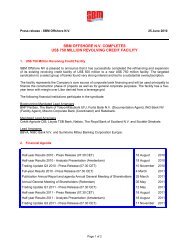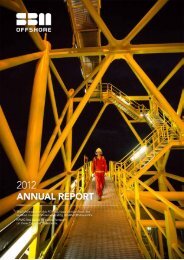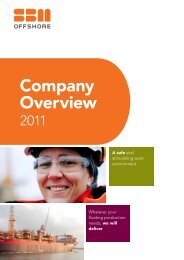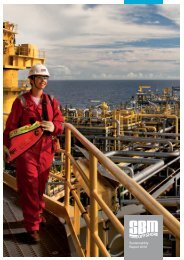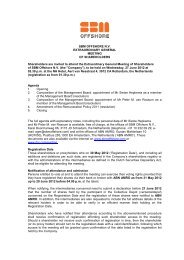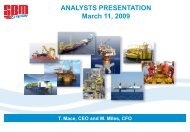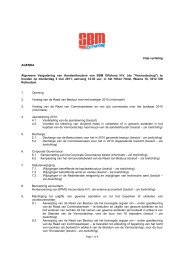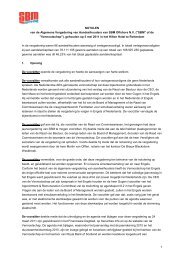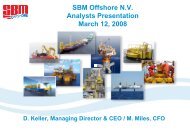Annual Report 2010 - SBM Offshore
Annual Report 2010 - SBM Offshore
Annual Report 2010 - SBM Offshore
You also want an ePaper? Increase the reach of your titles
YUMPU automatically turns print PDFs into web optimized ePapers that Google loves.
amount by which the asset’s carrying amount exceeds<br />
its recoverable amount. The recoverable amount is<br />
the higher of an asset’s fair value less costs to sell and<br />
value in use. For the purpose of assessing impairment,<br />
assets are grouped at the lowest level for which there<br />
are separately identifiable cash flows (cash-generating<br />
units). Non-financial assets other than goodwill that<br />
have been impaired are reviewed for possible reversal<br />
of the impairment at each balance sheet date.<br />
Recoverable amounts are determined based on valuein-use<br />
calculations. These calculations require the use<br />
of estimates.<br />
Non-current assets (or disposal groups)<br />
held for sale<br />
Non-current assets (or disposal groups) are classified<br />
as held for sale when their carrying amount is to be<br />
recovered principally through a sale transaction and<br />
a sale is considered highly probable. They are stated<br />
at the lower of the carrying amount and fair value less<br />
costs to sell if their carrying amount is to be recovered<br />
principally through a sale transaction rather than<br />
through continuing use.<br />
Financial assets<br />
The Company classifies its financial assets in the following<br />
categories: the Loans and Receivables, the<br />
Available for sale and the financial assets at Fair value<br />
through profit or loss. The classification depends on the<br />
purpose of the financial asset. Management determines<br />
the classification at initial recognition.<br />
Loans and receivables are non-derivative financial<br />
assets with fixed or determined payments that are not<br />
quoted in an active market. They are included in current<br />
assets, except for maturities greater than 12 months<br />
after the end of the reporting period. These are classified<br />
as non-current assets. The Company’s loans and<br />
receivables include finance lease receivables, other<br />
loans and receivables, and other financial assets.<br />
Impairment of financial assets<br />
The Company assesses whether there is objective<br />
evidence that a financial asset or group of financial<br />
assets is impaired at the end of each reporting date. A<br />
financial asset or a group of financial assets is impaired<br />
Financial Review / Financial Statements <strong>2010</strong><br />
and impairment losses are incurred only if there is<br />
objective evidence of impairment as a result of one or<br />
more events that occurred after the initial recognition of<br />
the asset (a ‘loss event’) and that loss event (or events)<br />
has an impact on the estimated future cash flows of the<br />
financial asset or group of financial assets that can be<br />
reliably estimated.<br />
The criteria that the Company uses to determine<br />
whether there is objective evidence of an impairment<br />
loss include:<br />
• significant financial difficulty of the obligor;<br />
• a breach of contract, such as a default or delinquency<br />
in interest or principal payments;<br />
• the Company, for economic or legal reasons relating<br />
to the borrower’s financial difficulty, granting to<br />
the borrower a concession that the lender would not<br />
otherwise consider;<br />
• it becomes probable that the borrower will enter<br />
bankruptcy or other financial reorganisation;<br />
• national or local economic conditions that correlate<br />
with defaults on the financial assets.<br />
The amount of the loss is measured as the difference<br />
between the asset’s carrying amount and the present<br />
value of the estimated future cash flows (excluding<br />
future credit losses that have not been incurred)<br />
discounted at the financial asset’s original effective<br />
interest rate. The asset’s carrying amount is reduced<br />
and the amount of the loss is recognised in the income<br />
statement. If the financial asset has a variable interest<br />
rate, the discount rate for measuring any impairment<br />
loss is the current effective interest rate determined<br />
under the contract.<br />
If, in a subsequent period, the amount of the impairment<br />
loss decreases and the decrease can be related<br />
objectively to an event occurring after the impairment<br />
was recognised, the reversal of the previously recognised<br />
impairment loss is recognised in the income<br />
statement.<br />
Impairment on trade and other receivables is described<br />
in the accounting policy with respect to trade and other<br />
receivables.<br />
Inventories<br />
Inventories are stated at the lower of cost and net<br />
<strong>SBM</strong> <strong>Offshore</strong> – <strong>Annual</strong> <strong>Report</strong> <strong>2010</strong> 121



